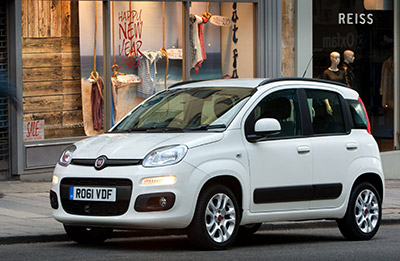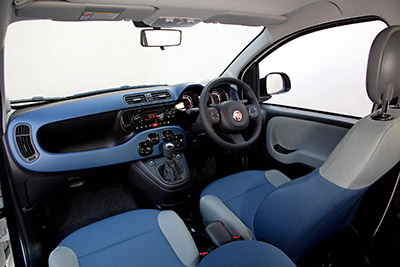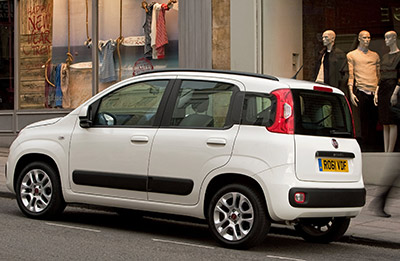MOTORING: A PANDA FOR THE TOWN
 When people ask what I do for a living, I can usually place a pretty safe bet on what the follow-up question will be… “So, what’s the best car you’ve driven?”
When people ask what I do for a living, I can usually place a pretty safe bet on what the follow-up question will be… “So, what’s the best car you’ve driven?”
That, though, is a difficult question to answer. However, if it comes down to one of the most fun day-to-day cars I’ve ever driven, the answer is simple: the 1,4-litre Fiat Panda 100hp, launched in 2007. As you can imagine, that usually raises some eyebrows … The truth is, though, it was such a fun, smile-inducing, cracker of a mini-car. I even considered – and still wouldn’t mind – buying one.
It was therefore with much excitement that I received the latest, third-generation Panda for testing – the top-of-the-range 1,2-litre Lounge model. This little car faces some stiff competition in the A-segment, city car corner of the market. The Kia Picanto and Hyundai i10 offer similar style in a similarly-sized package, while new, well-priced, entry-level B-segment models from Renault and Peugeot (the new Clio and 208, respectively) throw that plus an added dose of practicality and space into the mix for similar outlay. Of course, three of South Africa’s best-selling, and again larger, models feature in this price range as well – the VW Polo Vivo, Ford Figo and Toyota Etios.
It’s a very mixed segment of the market with some very good little cars on offer. Game over for the Panda, then? Not necessarily … So what does it offer?
Being Italian, it certainly has visual charm. The new generation takes the same basic shape and design elements as its predecessor but gone are the hard, square edges in all the features which are now softer and rounded-off. This design element is echoed in every conceivable feature, even the 15-inch allow wheels. Overall it’s a cute yet good-looking design that is immediately recognisable as a Panda.
 The interior continues with the funky “rounded square” theme. Everywhere too; from the ventilation outlets and controls, to the speaker grilles, instrument surrounds, gearknob and, even, the steering wheel. It works exceptionally well and is a refreshing and upbeat environment – just what one needs when whizzing around the city. You can even choose from three colours for the dash, door handles and steering wheel centre.
The interior continues with the funky “rounded square” theme. Everywhere too; from the ventilation outlets and controls, to the speaker grilles, instrument surrounds, gearknob and, even, the steering wheel. It works exceptionally well and is a refreshing and upbeat environment – just what one needs when whizzing around the city. You can even choose from three colours for the dash, door handles and steering wheel centre.
The electronic climate control and audio system controls are finished in a classy, upmarket-feeling piano black plastic while the squared-off steering wheel and gearknob are clad in soft-touch leather on Lounge models. The rest of the interior is, however, finished off with hard plastics which also presented some sharp edges around certain touch-points. Let’s not forget though, this is a “budget” car after all.
Created for the budget segment it may be, but the Panda offers some impressive accessories, especially in Lounge trim. Fitted are front electric windows, the aforementioned electronic climate control, a full on-board computer and the familiar Blue&Me Bluetooth audio system. Developed in partnership with Microsoft for Fiat/Alfa-Romeo, this system allows Bluetooth hands-free connectivity as well as text message reading. Audio devices, ironically for a Bluetooth system, need to be connected by USB … The system also has an impressive voice command system.
Safety features include four airbags, ABS anti-lock braking, brake assist, Isofix child seat mountings and an alarm/immobiliser.
So, it has the style and it has the toys, but does it turn you on around the town? Well, motivation comes from a willing but low-on-power 51 kW, 102 Nm 1,2-litre four-cylinder engine. It offers enough oomph to keep up with the daily traffic (it takes 14,2 seconds to reach 100 km/h, so you won’t necessarily lead the pack) but really does struggle going up-hill and maintaining high speeds. The trump card of these city runabouts, though, is their claimed fuel consumption, for which Fiat quotes 5,2 l/100 km on the combined driving cycle.
The car’s on-board computer said I averaged 7,6 l/100 km in very mixed driving during the test week.
It doesn’t, then, have the power to set your pants on fire but, as with the previous version, offers superb grip and excellent, powerful brakes which, when combined with its light weight, makes it a lot of fun to chuck around. It is exceptionally easy to manoeuvre and also features a “city” steering mode that further lightens the electronic steering.
 The ride is also good for such a little car, Fiat’s engineers having done a good job with the suspension setup. Being a city car, one can get a little uncomfortable on long journeys (your bum gets rather numb …) thanks in large part to the flat and somewhat hard seats. (Oh, the front passenger seat also folds flat to reveal a handy “table”.) It’s also surprisingly spacious, offering decent storage space and good visibility. Like an exceptionally good lover, it leaves you feeling that it’s bigger than it really is.
The ride is also good for such a little car, Fiat’s engineers having done a good job with the suspension setup. Being a city car, one can get a little uncomfortable on long journeys (your bum gets rather numb …) thanks in large part to the flat and somewhat hard seats. (Oh, the front passenger seat also folds flat to reveal a handy “table”.) It’s also surprisingly spacious, offering decent storage space and good visibility. Like an exceptionally good lover, it leaves you feeling that it’s bigger than it really is.
So, does the new little Fiat measure up to the others in its segment? On looks, yes. But price and spec, no, unfortunately not. At R167 990 the Lounge model is priced a bit too high, the lesser-specc’d Pop model perhaps offering better value. A three-year/100 000 km full maintenance plan and warranty is included, though.
Does it hold the same space in my heart as the old model? It did worm its way in there, but not in the same way, unfortunately. It’s still a likable little car though, if you’re willing to spend that bit more than its rivals.
Hmmm I like. Looked at the “old shape” model years ago when I was in the market but the somewhat “pram” look put me off. While this one still retains the general Panda shape, they have refined it a lot and made it look a lot more sexy. Worth a 2nd look, I’d say.